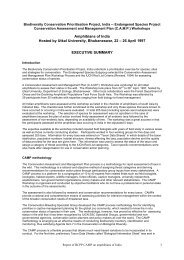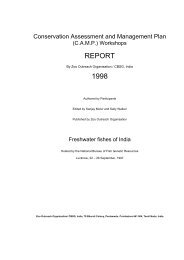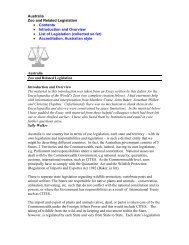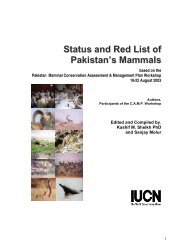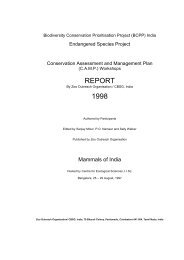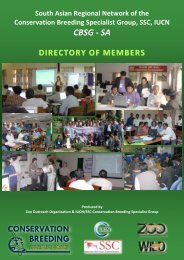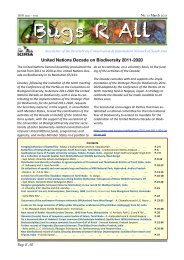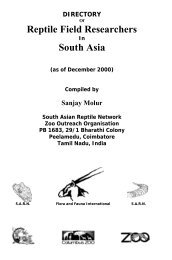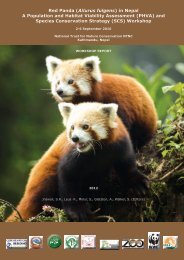South Asian Chiroptera CAMP report 2002 - Zoo Outreach ...
South Asian Chiroptera CAMP report 2002 - Zoo Outreach ...
South Asian Chiroptera CAMP report 2002 - Zoo Outreach ...
Create successful ePaper yourself
Turn your PDF publications into a flip-book with our unique Google optimized e-Paper software.
Seventeen species of bats are endemic to <strong>South</strong> Asia. Only 8 of the 123 species of <strong>South</strong> <strong>Asian</strong> <strong>Chiroptera</strong>assessed in the C.A.M.P. workshop have been categorized as Data Deficient, a high contrast to 52 out of 102Indian species, which were assessed at the 1997 Mammal C.A.M.P. workshop.Threats to bats include human interference leading to habitat loss, loss of habitat quality, deforestation, directhuman interference both in forest areas and in human settlements where bats have colonized. Although 40% of<strong>Chiroptera</strong> were assessed and categorized as Least Concern there is yet reason for vigilance even for thesespecies. The assessment was conducted at the species level only, which did not include at least 139 subspecies,some of them highly restricted to small areas such as Andaman & Nicobar Islands and Sri Lanka. Thesesubspecies and even individual populations of species may be under tremendous pressure leading to loss ofbiodiversity and resulting ecological impact.RecommendationsResearch recommendations confirmed that bats are one of the least studied mammalian groups in the region.Information for many species is based only on museum or literature references, with no recent population ordistributional information. Therefore, chiroptera surveys make up the primary research recommendation fornearly all bats (120 species). Ecological studies were also very strongly recommended for better understandingof the status and economic value of species as well as to provide justification for upgrading bats in nationallegislation. Other research recommendations include life history studies, limiting factor research, taxonomicstudies, genetic studies, and population and habitat viability analysis.Management recommendations focused on the need for periodic monitoring to follow surveys, the lack ofwhich has hindered the understanding of population structure and dynamics of bats of the region. Otherrecommendations included habitat management and public awareness. Habitat management is crucial from notonly conserving roost areas such as caves, trees, old buildings, temples and wells, but also in conserving itssources of food, be it fruits or insects. Education should form a part of management as man is the only genuinethreat to bats.Field surveys, monitoring and conservation priorities were discussed by the Working Group. The grouprecommended surveys in unknown or unsurveyed localities, surveys of all the 8 Data Deficient species andresurveys in some areas where bats seemed to have disappeared. Modern scientific field techniques for fieldstudies should be utilized with conservation as the first priority of the studies. Training was recommended forthis as well as for identification of bat species so that monitoring is effective. In regard to monitoring, batsshould be included in association with routine wildlife monitoring as well as in Environmental ImpactAssessment (including effect of pesticides). Threatened species should be prioritised so that their populationtrends can be ascertained. Study and documentation of pollination and seed dispersal by bats in differentecosystems, would help improve the image of bats. For captive management, two Indian endemic bats wererecommended for captive breeding programmes, Hipposideros durgadasi (Khajuria, 1970) and Latidenssalimalii Thonglongya, 1972. Forty species were recommended for captive management for education andpublic awareness.Legislation and policy issues included a priority recommendation as the removal of Megachiroptera or fruit batsfrom Schedule V (Vermin) of the Indian Wildlife (Protection) Act, 1972 with legislation to extend to otherspecies of <strong>Chiroptera</strong>. Over time, legislation and forest management plans and guidelines should includecontrol measures for disturbance, selling, bartering whole or parts of bats, protection of key roosting sites andimportant habitats of bats, particularly of threatened and endemic species. Migratory bat species should beidentified and appropriate international agreement drafted.<strong>South</strong> <strong>Asian</strong> <strong>Chiroptera</strong> C.A.M.P. Report, <strong>2002</strong> 5



